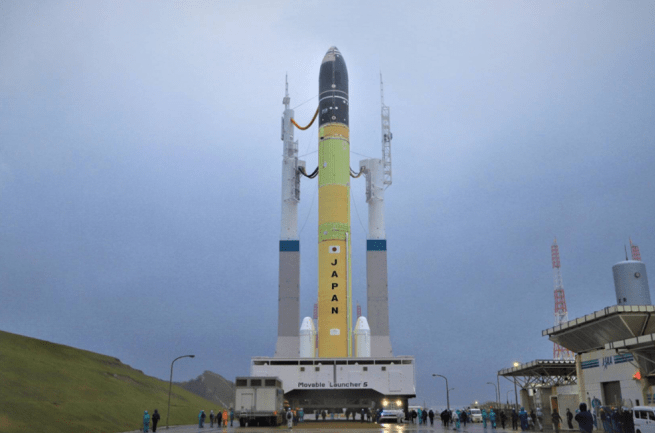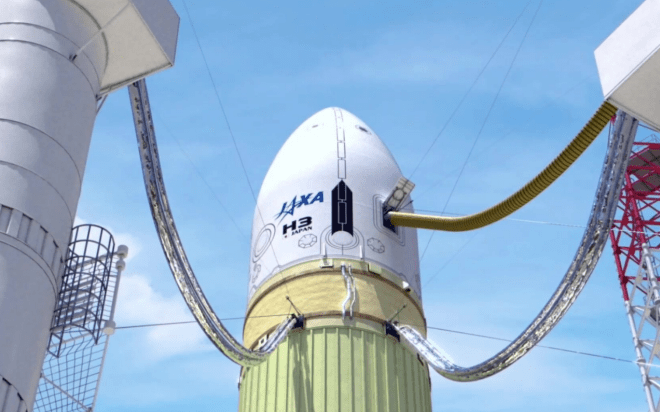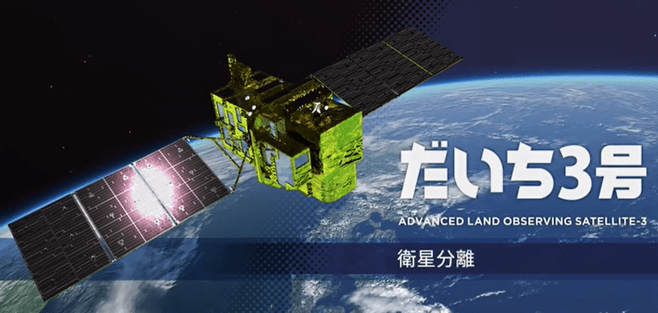Japan’s new-generation carrier rocket H-3 tried to launch again. Although the rocket successfully ignited and lifted off, problems occurred during the flight, and the first flight mission ended in failure. The H-3 rocket had previously attempted its maiden flight on February 17, but the launch was aborted because the engine failed to ignite successfully.
This is the second time in the past six months that Japan’s new rocket has failed to launch. In the case of successive failures in the launch of new rockets, Japan’s space development prospects have also sparked heated discussions.

The road to the development of Japan’s new generation launch vehicle H-3 is full of twists and turns. It was originally planned to make its first flight in 2020.
Plan to seize the gap after Russia left the international launch market
After the failure of the H-3 rocket launch, the Japan Aerospace Exploration Agency (JAXA) held a press conference, stating that the H-3 rocket that was ordered to self-destruct may have fallen into the sea east of the Philippines together with the satellite it carried.
According to Japan’s Kyodo News Agency, the launch failed because the second-stage engine failed to ignite as planned, and the Japan Aerospace Exploration Agency sent a self-destruct command to the rocket about 15 minutes after launch. JAXA did not announce the specific reason for the failure, saying that it will investigate in the future.
The road to the first flight of the H-3 rocket can be described as full of twists and turns. The rocket performed a launch mission on February 17, but the launch was urgently suspended because the engine failed to ignite successfully. It was later found out that the control system detected an abnormal signal after the LE-9 main engine of the first stage ignited, so the flight control software stopped counting down and did not send an ignition signal to the solid rocket propulsion, resulting in the suspension of the launch. After investigation, it was found that the abnormal signal was detected because of an abnormality in the power supply system of the LE-9 main engine of the rocket’s first stage. After finding out the reason, it was planned to launch again on March 6, but it was postponed to the 7th due to weather reasons.
The H-3 rocket is a follow-up model of the H-2A, which is a liquid launch vehicle. It was jointly developed by JAXA and Mitsubishi Heavy Industries in 2014, with a research and development cost of 200 billion yen (about 10.12 billion yuan). According to the information released by Japan, the H-3 rocket has a total length of 63 meters, a diameter of 5.2 meters, and a take-off weight of 422 tons. By carrying different numbers of main engines and bundled with different numbers of boosters, rockets with different carrying capacities can be produced, with 2 to 7 tons of static transfer orbit carrying capacity.
In the view of Pang Zhihao, the chief scientific communication expert of national space exploration technology, the H-3 rocket is a relatively advanced rocket that uses liquid oxygen and liquid hydrogen engines. Pang Zhihao told The Paper (www.thepaper.cn) that the H-3 rocket used a more powerful engine based on the H-2A rocket, and also adopted many mature technologies to reduce costs, but the development of the H-3 rocket was not smooth. Due to engine and other problems, the launch was postponed many times. The launch was originally planned to be in 2020, but it was postponed to this year, and the first flight failed again.
“This also shows that the risk of developing a new type of rocket is still relatively high, and all countries must face such problems.” Pang Zhihao pointed out.
As a new generation of liquid carrier rocket in Japan, H-3 has high hopes. Its biggest feature is low launch and manufacturing costs, and it is regarded as the future star of Japan’s aerospace industry. Japan’s “Yomiuri Shimbun” published an article stating that one of the goals of developing the H-3 rocket is to minimize the cost. For example, the assembly parts make full use of 3D printing technology, and its launch cost is much lower than that of the H-2A rocket. About 10 billion yen (about 506 million yuan) fell to about 5 billion yen (about 253 million yuan).
With the development of commercial spaceflight, the demand for commercial launch services is increasing day by day, and many companies are deploying “satellite constellations” for Internet services. In the context of Russia being sanctioned, Japan hopes that the new rocket can seize the gap after Russia leaves the international launch market.
“Nikkei Asia” previously published an article pointing out that at a time when the conflict between Russia and Ukraine is tense, governments of various countries are working hard to strengthen military capabilities in space. Last year, after the conflict between Russia and Ukraine broke out, in response to sanctions imposed by Western countries, it announced its withdrawal from the international launch market. Iwawa Igarashi, director of the sales department of Mitsubishi Heavy Industries Cosmos Division, said: “We receive twice as many inquiries about related businesses as (before Russia withdrew).”
However, the plan cannot keep up with the changes, and the failure of the first flight will obviously affect the H-3 rocket’s seizure of the international launch market.

The H-3 rocket has a carrying capacity of 2 to 7 tons to a geostationary transfer orbit.
How much impact will it have on the future development of Japan’s aerospace industry?
Regarding the failure of the first flight of the H-3 rocket, Japan Aerospace Exploration Agency (JAXA) Chairman Yamakawa Hiroshi apologized and said: “We have failed the expectations of the people, and I am very sorry.” I am sorry that this result occurred in a situation that many ordinary people are also very concerned about.”
Nagayama Chuanhong said, “H-3 is a rocket that is very important to the government and the people. We will work to find out the reasons for the failure and make persistent efforts.” Japan’s Kyodo News reported that Nagayama Chuanhong did not mention whether he would resign .
In addition to apologizing, Nagayama Chuanhong still affirmed the H-3 rocket. Yamakawa said, “The main engine of the newly developed H-3 rocket has performed as expected. I think it is perfect.” Katsuhiko Hara, a council member of the Ministry of Education, Culture, Sports, Science and Technology who attended the press conference, said, “It is conceivable that there will be some kind of impact. We will seriously discuss it on the basis of finding out the cause of this failure.”
This is the second launch failure of Japan’s new rocket in the past six months. In October last year, Japan launched the “Epsilon” carrier rocket, but it failed to fly normally during the flight and the launch failed. “Epsilon” is a solid launch vehicle jointly developed by Japan Aerospace Exploration Agency (JAXA) and Ishikawajima Harima Heavy Industries (IHI). 1.5 tons.
The “Epsilon” rocket is also a solid launch vehicle developed by Japan to reduce space launch costs and enhance international competitiveness. Its launch price is about 37 million US dollars, which is nearly half that of the previous generation M-5 rocket. The rocket made its first successful flight in September 2013.
Singapore’s “Lianhe Zaobao” reported that Japan’s main rocket was difficult to produce, and the “Epsilon” launched in October last year also failed. This will definitely deeply affect Japan’s space development prospects and space strategy.
Japanese Prime Minister Fumio Kishida issued the “Space Basic Plan Project Table” at the end of 2021, which clarified the country’s space strategic goals. It is necessary to let Japanese astronauts land on the moon in the second half of the 2020s, and to integrate the space strategy with the four-party cooperation framework of Japan, the United States, India and Australia. Combine. “Nihon Keizai Shimbun” pointed out that the development of the H-3 rocket by the authorities is also to help the United States in the exploration of the moon and Mars.

The “Dadi-3” satellite is equipped with a payload developed by the Ministry of Defense – the test payload of the “Dual Wavelength Infrared Sensor”.
It is worth mentioning that the failure of the H-3 rocket launch this time will also affect the plan of the Ministry of Defense of Japan to build an anti-missile system. The test payload of the “Infrared Sensor”, a key technology for missile warning satellites, is used to detect and track ballistic missile launches.
Japan has been developing space infrared sensors for missile early warning since 2014. According to the “Yomiuri Shimbun” report at the time, the development of the sensor will be jointly carried out by the Japan Aerospace Exploration Agency and the Ministry of Defense of Japan. The Japanese government budgeted about 50 million yen (about 3.13 million yuan) for development in the 2014 budget. funding.
“Japan’s use of civil earth observation satellites to carry missile early warning satellites to carry out preliminary tests is mainly to reduce costs on the one hand; on the other hand, it is to observe the response of the international community and wait for the right time to launch specialized missile early warning satellites. This is also Japan’s A common way to develop many weapons.” Aerospace expert Huang Zhicheng previously pointed out to The Paper.
“Nikkei Asia” pointed out that in Japan’s military construction, space early warning capabilities are the core of countering Russian and North Korean missile attacks. It is planned that by 2028, the number of Japanese intelligence-gathering satellites will be doubled to 10, and they will be geosynchronous. Surveillance satellites in orbit. The H-3 rocket is the key to these missions.
Currently, the Ministry of Defense of Japan is considering determining the framework of the constellation during the next mid-term defense plan (fiscal year 2023-2027). It also plans to combine commercial satellite imagery and US intelligence information to enhance information collection capabilities.
In December last year, Japanese media reported that the Ministry of Defense of Japan planned to deploy a constellation of 50 small satellites in low-Earth orbit to track hypersonic missiles. The satellites will work together to frequently fly over specific targets, giving Japan more time to assess whether enemy military units are preparing to launch hostilities, the sources said. In addition, Japan and the United States are considering jointly developing new technologies to intercept hypersonic missiles, so as to destroy incoming missiles at altitudes that cannot be reached by existing anti-missile systems.



GIPHY App Key not set. Please check settings